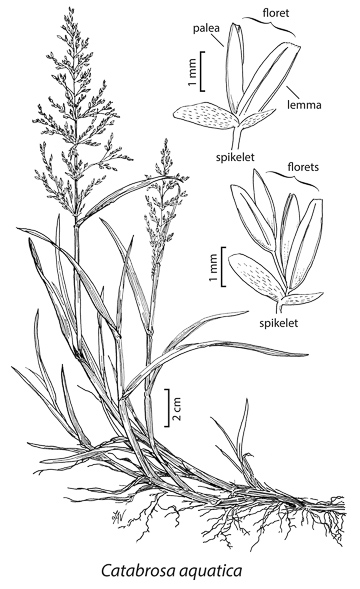|
Family: Poaceae |
Mary E. Barkworth Plants perennial; not rhizomatous, sometimes stoloniferous. Culms 5–70 cm, usually decumbent and rooting at the lower nodes; nodes glabrous. Sheaths closed; auricles absent; ligules membranous; blades flat. Inflorescences open panicles, with at least some branches longer than 1 cm. Spikelets pedicellate, laterally compressed to terete, with (1)2(3) florets; rachillas glabrous, prolonged beyond the base of the distal fertile floret, empty or with reduced florets; disarticulation above the glumes and beneath the florets. Glumes unequal, much shorter than the lemmas, scarious, veinless or the upper glumes with 1 vein at the base, apices rounded to truncate, unawned; calluses short, blunt, glabrous; lemmas glabrous, conspicuously 3-veined, veins raised, rounded over the midvein, apices rounded to truncate, erose and scarious, unawned; paleas subequal to the lemmas, 2-veined; lodicules 2, truncate, irregularly lobed; anthers 3; ovaries glabrous. Caryopses shorter than the lemmas, concealed at maturity, fusiform; hila ovoid. x = 5. Name from the Greek katabrosis, ‘eating up’ or ‘corrosion’, a reference to the appearance of the lemma apices. Catabrosa grows in marshes and shallow waters of the Northern Hemisphere and South America. It resembles members of the Meliceae in its closed leaf sheaths, truncate, scarious lemma apices, and chromosome base number, but lacks the distinctive lodicule morphology of that tribe. Some features support its inclusion in the Poeae. The lodicules are similar to those found elsewhere in the Poeae, and the closed leaf sheaths are not uncommon there. Molecular analyses, almost all of which include only Catabrosa aquatica, also support its placement in the Poeae ( Soreng et al. 1990; Choo et al. 1997; Gillespie et al. 2015). The scarious glumes and prominently 3-veined lemmas are unusual in both the Poeae and Meliceae, but are also found in Cutandia of the Poeae. The number of species recognized in Catabrosa varies from 2-10 or so. Eight species have been recognized since 2007, one of which (Catabrosa minor) reflects elevation of an infraspecies to species rank and one (Catabrosa drakensbergensis) a transfer from another genus (Tropicos 2018). There is no recent morphological study of the genus. Only one species has been recognized in North America, the widespread Catabrosa aquatica. NatureServe (2018) includes two varieties of C. aquatica, var. aquatica and var. laurentiana, with the latter being endemic to southeastern Canada. Their status, and that of other taxa in the genus, have not been independently evaluated for this treatment. Only one species, Catabrosa aquatica, has been recognized in North America north of Mexico. SELECTED REFERENCES: Choo, M.K., R.J. Soreng and J.I. Davis. 1994. Phylogenetic relationships among Puccinellia and allied genera of Poaceae as inferred from chloroplast DNA restriction site variation. American Journal of Botany 81: 119-126. Gillespie, L.J., A. Archambault, and R.J. Soreng. 2007. Phylogeny of Poa (Poaceae) based on trnT-trnF sequence data: Major clades and basal relationships. Aliso 23: 420-434; Soreng, R.J., J.I. Davis, and J.J. Doyle. 1990. A phylogenetic analysis of chloroplast DNA restriction site variation in Poaceae subfam. Poöideae. Pl. Syst. Evol. 172:83–97; Tropicos. 2018. Catabrosa. Viewed November 3, 2018). |


